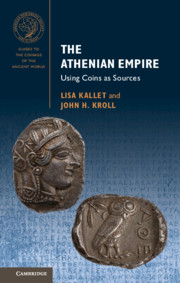Refine search
Actions for selected content:
23990 results in Ancient history
Graphs
-
- Book:
- The Cosmos in Ancient Greek Religious Experience
- Published online:
- 04 November 2020
- Print publication:
- 29 October 2020, pp xiii-xiii
-
- Chapter
- Export citation
One - Introduction
-
- Book:
- The Cosmos in Ancient Greek Religious Experience
- Published online:
- 04 November 2020
- Print publication:
- 29 October 2020, pp 1-12
-
- Chapter
- Export citation
Four - Astronomy and Perceptual Cognition in Apolline Cults
-
- Book:
- The Cosmos in Ancient Greek Religious Experience
- Published online:
- 04 November 2020
- Print publication:
- 29 October 2020, pp 71-114
-
- Chapter
- Export citation
Five - The Cosmos in Manifestations of Identity, Memory, and Remembrance
-
- Book:
- The Cosmos in Ancient Greek Religious Experience
- Published online:
- 04 November 2020
- Print publication:
- 29 October 2020, pp 115-153
-
- Chapter
- Export citation
Two - Methodological Advances, Approaches, and Considerations
-
- Book:
- The Cosmos in Ancient Greek Religious Experience
- Published online:
- 04 November 2020
- Print publication:
- 29 October 2020, pp 13-30
-
- Chapter
- Export citation
Acknowledgements
-
- Book:
- The Cosmos in Ancient Greek Religious Experience
- Published online:
- 04 November 2020
- Print publication:
- 29 October 2020, pp xv-xvi
-
- Chapter
- Export citation
Copyright page
-
- Book:
- The Cosmos in Ancient Greek Religious Experience
- Published online:
- 04 November 2020
- Print publication:
- 29 October 2020, pp iv-iv
-
- Chapter
- Export citation
Introduction
-
- Book:
- Livy: <I>Ab urbe</I> <I>condita</I> Book XXII
- Print publication:
- 29 October 2020, pp -
-
- Chapter
- Export citation
Notes
-
- Book:
- The Cosmos in Ancient Greek Religious Experience
- Published online:
- 04 November 2020
- Print publication:
- 29 October 2020, pp 215-238
-
- Chapter
- Export citation
Frontmatter
-
- Book:
- Livy: <I>Ab urbe</I> <I>condita</I> Book XXII
- Print publication:
- 29 October 2020, pp -
-
- Chapter
- Export citation
Works Cited
-
- Book:
- Livy: <I>Ab urbe</I> <I>condita</I> Book XXII
- Print publication:
- 29 October 2020, pp -
-
- Chapter
- Export citation

The Making of Empire in Bronze Age Anatolia
- Hittite Sovereign Practice, Resistance, and Negotiation
-
- Published online:
- 27 October 2020
- Print publication:
- 12 November 2020

The Athenian Empire
- Using Coins as Sources
-
- Published online:
- 19 October 2020
- Print publication:
- 05 November 2020
-
- Textbook
- Export citation
Preface
-
- Book:
- Plato's Pigs and Other Ruminations
- Published online:
- 26 September 2020
- Print publication:
- 15 October 2020, pp xi-xiii
-
- Chapter
- Export citation
Chapter 1 - Debts to Nature
-
- Book:
- Plato's Pigs and Other Ruminations
- Published online:
- 26 September 2020
- Print publication:
- 15 October 2020, pp 14-44
-
- Chapter
- Export citation
Contents
-
- Book:
- Plato's Pigs and Other Ruminations
- Published online:
- 26 September 2020
- Print publication:
- 15 October 2020, pp vii-vii
-
- Chapter
- Export citation
Chapter 6 - Cynics and Stoics
-
- Book:
- Plato's Pigs and Other Ruminations
- Published online:
- 26 September 2020
- Print publication:
- 15 October 2020, pp 131-154
-
- Chapter
- Export citation
Note on Sources and Citation
-
- Book:
- Plato's Pigs and Other Ruminations
- Published online:
- 26 September 2020
- Print publication:
- 15 October 2020, pp xiv-xvi
-
- Chapter
- Export citation
Chapter 4 - A City for Pigs
-
- Book:
- Plato's Pigs and Other Ruminations
- Published online:
- 26 September 2020
- Print publication:
- 15 October 2020, pp 91-109
-
- Chapter
- Export citation
Chapter 2 - Anaximander for the Anthropocene
-
- Book:
- Plato's Pigs and Other Ruminations
- Published online:
- 26 September 2020
- Print publication:
- 15 October 2020, pp 45-63
-
- Chapter
- Export citation
